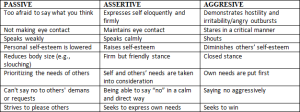Assertiveness is a key component of communication in many contexts, including the workplace and interactions with friends and family. You will discover everything about assertive communication right here.

Have you ever had trouble expressing yourself clearly while remaining non-aggressive? Or, do you find it difficult to express your needs? A helpful strategy for balancing our relationships with meeting our own needs is assertive communication. In this post, we’ll discuss assertive communication, passive communication, and aggressive communication in order to teach you how to speak more assertively.
Definition of Assertive Communication
Here’s an example that you might be familiar with. You have a full schedule and a short deadline for a certain endeavor (like a homework assignment or work requirement). During this difficult moment, one of your close friends contacts you and begs you to help her out with a last-minute favor. In order to keep on course, you need to say no, but you also don’t want to appear to be a horrible buddy.
In this situation, what would you do? Perhaps you would be adamant and say “no,” or perhaps you can’t say no because you struggle with assertiveness in social situations, which ultimately leads to long-term stress.
Although the word “assertive” is presumably already recognizable to you, what does assertive communication actually entail? It is “the ability to speak and interact in a manner that considers and respects the rights and opinions of others while also standing up for your rights, needs, and personal boundaries” (Pipas & Jaradat, 2010, pp. 649).
To put it another way, assertive communication entails confidently asserting your needs in a direct yet calm and reasonable manner while also considering the needs of the other person. This is an important form of communication in many areas of life because it allows you to express your wants, needs, or opinions and stand up for yourself when necessary.
Additionally, it can make it easier for you to say “no” to chores or plans that may not be in your best interests. The intricacies of assertive communication and examples of what it might look like in practice will be covered in the following section.
Assertive Communication – Characteristics
The traits listed below are stated by Bishop (2013) and Pipas and Jaradat (2010). The last four concern linguistic traits, while the first five concern non-verbal ones.
1. Direct eye contact: communicates that the person is not intimidated
2. Assertive posture/stance: balance between looking too aggressive and too weak
3. Tone of voice: should be strong, but not aggressive (e.g., raising voice)
4. Facial expression: important to not express anger or anxiety
5. Timing: the person must be socially aware to assertively communicate at the right time (e.g., asking for a raise in the middle of a business meeting is not likely to be well received)
6. Clarity: using specific words that clearly communicate needs
7. Non-threatening: the person should not blame or threaten the other person (e.g., you better do this, or else)
8. Positive: framing a request in a positive way (e.g., “I bought two laundry hampers. Would you please place your laundry in one of them?”) is more effective than a negative request (e.g., “Will you stop leaving your laundry everywhere?”)
9. No criticism: although it might be tempting, it’s important to not criticize yourself (e.g., “I’m overly sensitive”) or others (“Why are you so mean?”) when trying to be assertive
There is undoubtedly a narrow line between being assertive in your communication and coming across as either too forceful or too passive. Let’s examine these many boundaries and elements of assertive communication in more detail.
Passive vs. Aggressive vs. Assertive
Let’s use an example from the beginning of this article. There are three ways you can answer if a friend asks you to do a favor for her but you can’t because you need to concentrate on a project of your own:
Aggressive answer: “Definitely not! Always at the last minute, you ask for favors! Before you expect me to put everything on hold to help you, you need to start learning how to manage your life.
Passive answer: “Of course, yeah. No problem at all.” – This way, you don’t want to do it, because it is hard for you to achieve it, since you already have your own work to do, but passively answering “yes” get you to a really stressful situation.
Assertive answer: “Unfortunately, I have a lot of work to go through today, as much as I’d love to assist. But I really hope you can find someone else.”
The aggressive and passive answers, it is clear, have certain issues. Passive reactions are agreeable and weak, whereas aggressive responses may come across as overly harsh or rude. Here is a handy table that contrasts and compares the various traits of each communication style to further illustrate them.

Think about the communication style you employ most often as you read these. Do you tend to be more aggressive, forceful, or passive? Or perhaps you are aggressive in some circumstances but meek in others? Regardless of who you are, evidence demonstrates that aggressive communication is the best course of action for a number of reasons. Continue reading to learn why in the following section.
Why Is Assertive Communication a Successful Technique?
According to research, assertive communication has various advantages (e.g., Pipas & Jaradat, 2010; Bishop, 2013). Here are a few that are listed. People who use assertive communication are likely to have:
- A more positive view of oneself
- Better self-confidence
- Better self-control
- Greater feeling of self-worth
- Stronger connections
- Greater self-reflection
- Reduced feeling of depression and anxiety
- Improved capacity to stay out of social conflicts
- Better Health
- Better communication skills
- Greater regard for others’ viewpoints
- Increased self-esteem
Assertive communication – Examples
You could want to exercise more assertiveness at work or with friends and family (or perhaps both). There are a few suggestions for improving assertive communication that can be used in a variety of contexts.
- Make sure you express your feelings to the other person in a clear and concise manner by using “I” phrases, such as “I would want, I feel…” Typically, aggressive requests start with “you,” such as “You never do this…”
- Avoid using words like “always” or “never.”
- To convey your message, use clear verbs (such as “will” instead of “could” or “need” instead of “want”).
- Be respectful in your reaction to any comments you get, whether it is favorable or not.
Here are a few examples of assertive communication in statements:
- “I don’t agree with that. I see it this way…”
- “I appreciate you considering me, but I’m going to decline this time.”
- “Unfortunately, I’m unable to take on any new projects at this time.”
- “I value your viewpoint, but let’s agree we disagree.”
- “I believe I deserve a raise because my sales have improved by 10%.”
- “I know you didn’t intend it, but your comment offends me.”
- “I’d prefer it if you arrived on time the next time.”
Workplace examples of assertive communication
Workplace bullying is a problem that impacts job performance and satisfaction (Fisher-Blando, 2008).People who are the targets of this bullying frequently lack the ability to communicate assertively, which makes it difficult for them to stand out, ask for a promotion, ask questions, deny requests, and other things.
However, there are strategies to improve assertive communication at work:
- Making specific, concise requests
- Speaking up when it’s appropriate (instead of waiting and becoming frustrated)
- Determining your worth (for instance, how much are people who perform your profession often paid?)
- Speaking with your supervisor in private
- Refraining from apologizing while making a request
Although assertive communication can contribute to a more enjoyable work environment, it’s equally crucial to practice assertive communication outside of the office, such as with friends and family.
Examples of assertive interactions with family and friends
According to academics, assertiveness can be a “tool [used to make] your relationships more equal” (Alberti & Emmons, 2017, pp. 14). Honesty is necessary in close relationships, especially romantic ones. How does assertive communication function in interpersonal interactions? According to researchers, the following components are essential for forceful communication in relationships:
1. Being honest and at ease while expressing needs, feelings, and opinions
2. An equal distribution of power
3. Both individuals believe they are capable of defending themselves.
4. No one’s rights or beliefs are violated
5. Be direct and firm, but cheerful at all times
Keep in mind that being assertive entails taking both your own wants and the needs of the other person into account. When you simply think about yourself, you might start to communicate aggressively, which is not the path you want to pursue in a relationship that is based on mutual support. By employing the aforementioned techniques for assertive communication, you’ll increase your chances of developing and sustaining a satisfying and pleasant connection.
How can you be more assertive in your interactions with others?
The following advice is provided by Murphy (2011) to assist with assertiveness:
1. Reflect on your position in the relationship: take back your power and reflect on what you deserve in the relationship (e.g., if you live together, you deserve to be comfortable).
2. Identify your wants and needs: think about the changes you would like for a positive and successful relationship that will fulfill your needs.
3. Respectfully communicate this to the other person: use the assertive techniques listed above to share your needs.
Techniques for assertive communication
Role-playing is a method for assisting individuals in developing assertive communication skills. This method of changing behavior entails playing a part that could be difficult to play in real life. This method is occasionally used by counselors to teach assertive communication.
For instance, both verbal and nonverbal assertive skills could be helpful if you wish to confront a coworker who is treating you unfairly at work (mentioned earlier). This can be done in front of a mirror or with a friend or member of your family.
Role-playing can be a helpful and effective technique to develop assertive communication, according to research (e.g., Silverman, 2011; Kesten, 2011; Grey & Berry, 2004).
Thank you for reading. I hope you enjoyed it. Using assertive communication really does help in social interactions. I studied it in college, and used it in real life. And I’ve got convinced that this helps so much. I really hope it helps you out, especially if you have problems with communicating your needs or issues with others. Using “I” messages really does help, and definitely avoid ACCUSING others while expressing yourself. Talk it out in a soothing voice, with clear words and verbs. If you need more help, feel free to contact me here or on my facebook page. If I can, I will help you out with it. Have a good day! <3
Source: berkeleywellbeing.com
 MENTPSYCH Meet Your Self
MENTPSYCH Meet Your Self




